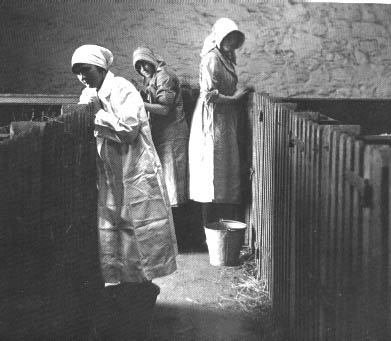Feeding Youngstock.
In between cooking meals and baking for the men of
the farm, cleaning the house, and handling the dairy
work, the women had outdoor chores to cope with.
At lambing the wife often
nursed weak lambs back to health, keeping
them warm in the "slow" oven of
the kitchen range. When the lambs were strong
enough to be penned outdoors in a byre
or outhouse, the women or children bottle
fed them there, but they were not allowed
to be "pets" for long. They
would be fostered onto a bereaved ewe as
soon as possible. Pet lambs soon grow up
to be
big, strong, demanding around humans and
a nuisance!
 |
On a dairy farm, women's maternal instincts
were often harnessed to the feeding of calves, who were left with
their mothers only for the first few days of life. After that,
the cows joined the milking herd and the calves were fed a ration
from the total milk output.
|
|
A calf has to be taught to drink from a bucket
by giving him a finger to suck, then leading his nose down into
the milk so he is sucking "up", rather than down in
his instinctive position. This requires patience and a knack of
"teasing" the calf into the right movement. Often the
teacher ends up with the bucket of milk over her feet when the
calf, in his impatience, "bumps" the bucket with his
nose as he would bump his mother's udder to make the milk flow
freely. Of course, once he has learnt how to drink, he no longer
needs a finger to suck, but the transition from "sucking
down" to "sucking up" may take a week.
|
|
Search
Museum
Front Doors
Farming in Cumbria
Dairy
Washday
Poultry
Seedtime
Haytime
The Farming Year
Transport
Wool
Animal
Treatment
Saddler's Workshop
The Forge
Quizzes
and Jigsaws
I
used that!
What IS
that??
Audio, video,
animations
Dalemain
UK Maps
Site Feedback
Links
Thanks
|